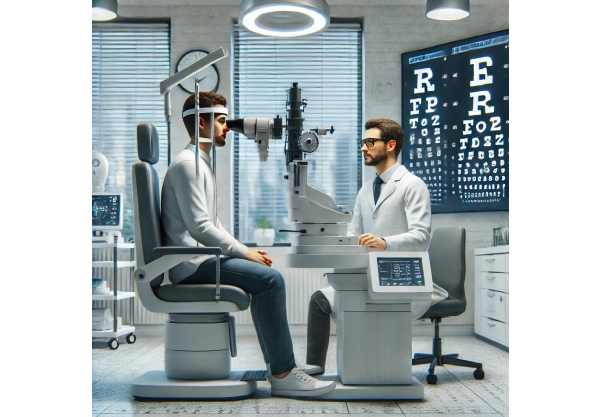
Smoking is widely recognized for its devastating effects on the lungs and heart, but its impact on eye health is often overlooked. For those who smoke, the potential damage goes beyond respiratory and cardiovascular issues—it also extends to vision. Our eyes, sensitive and intricate organs, are particularly vulnerable to the toxins found in cigarette smoke. Whether you are a long-term smoker or have recently picked up the habit, understanding the risks to your eyesight is crucial. This article delves into how smoking affects your eyes, potentially leading to serious conditions that can impair your vision and quality of life.
The Direct Impact of Smoking on Eye Health
When discussing the effects of smoking on health, most people think of lung cancer or heart disease. However, the eyes are equally at risk, and the consequences can be severe. The harmful chemicals in tobacco smoke can damage nearly every part of the eye, from the cornea to the optic nerve, leading to a range of vision problems. Understanding the direct impact of smoking on eye health can provide smokers with the motivation they need to consider quitting, or at the very least, taking steps to protect their vision.
How Smoking Harms the Eye’s Structure
To grasp the full extent of smoking’s impact on the eyes, it’s important to understand how smoking affects the various components of the eye. The chemicals in cigarette smoke can interfere with the delicate structures of the eye, causing both immediate irritation and long-term damage.
- Cornea and Conjunctiva:
The cornea and conjunctiva are the first parts of the eye to come into contact with the environment. The irritants in cigarette smoke can cause immediate discomfort, leading to symptoms such as redness, dryness, and a burning sensation. Chronic exposure to smoke can exacerbate these symptoms, leading to persistent dry eye syndrome. Dry eye occurs when the eye does not produce enough tears or when the tears evaporate too quickly, leading to irritation and inflammation. Smokers are more likely to suffer from dry eyes, as the chemicals in smoke disrupt tear production and tear film stability. - Lens:
The lens is crucial for focusing light onto the retina, allowing us to see clearly. Smoking significantly increases the risk of cataracts, a condition where the lens becomes cloudy, leading to blurred vision. Cataracts develop when proteins in the lens clump together, and smoking accelerates this process due to the oxidative stress caused by tobacco smoke. Smokers are up to three times more likely to develop cataracts compared to non-smokers, and they tend to develop them at an earlier age. This means that smokers may face vision impairment or even blindness if the cataract is not treated surgically. - Retina:
The retina is the light-sensitive layer at the back of the eye that sends visual signals to the brain. Smoking is a major risk factor for age-related macular degeneration (AMD), a condition that affects the central part of the retina called the macula. The macula is responsible for sharp, detailed vision, and damage to this area can lead to a loss of central vision, making it difficult to read, drive, or recognize faces. AMD is the leading cause of blindness in people over 50, and smokers are two to three times more likely to develop AMD than non-smokers. This risk increases with the number of cigarettes smoked over time. - Optic Nerve:
The optic nerve transmits visual information from the retina to the brain. Smoking increases the risk of optic neuropathy, a condition where the optic nerve becomes damaged, leading to a loss of vision. The toxins in cigarette smoke can reduce blood flow to the optic nerve, depriving it of essential nutrients and oxygen. This damage is often irreversible and can result in permanent vision loss. Smokers with a history of high blood pressure or diabetes are at an even greater risk of developing optic neuropathy.
Smoking and Increased Risk of Eye Diseases
Beyond the direct damage to the eye’s structure, smoking significantly increases the risk of developing various eye diseases, many of which can lead to permanent vision loss.
- Age-Related Macular Degeneration (AMD):
As mentioned earlier, smoking is a major risk factor for AMD. This disease is particularly concerning because it affects the central part of the vision, which is essential for tasks like reading and driving. AMD comes in two forms: dry and wet. Dry AMD is more common and progresses slowly, while wet AMD is more severe and can cause rapid vision loss. Smoking increases the risk of both types, and it can also reduce the effectiveness of treatments for wet AMD. - Cataracts:
Cataracts are another major concern for smokers. The oxidative stress caused by smoking damages the proteins in the lens, leading to the formation of cataracts. While cataracts can be treated with surgery, the condition can severely impair vision and quality of life if left untreated. Smokers are not only more likely to develop cataracts, but they also tend to do so at a younger age, increasing the likelihood of experiencing vision problems earlier in life. - Diabetic Retinopathy:
Smoking is a known risk factor for diabetes, and it can also exacerbate complications associated with the disease, including diabetic retinopathy. This condition occurs when high blood sugar levels damage the blood vessels in the retina, leading to vision loss. Smokers with diabetes are more likely to develop retinopathy, and the condition can progress more rapidly in smokers compared to non-smokers. This is because smoking reduces blood flow and oxygen to the retina, accelerating the damage caused by high blood sugar levels. - Uveitis:
Uveitis is an inflammation of the uvea, the middle layer of the eye, which includes the iris, ciliary body, and choroid. Smoking has been linked to an increased risk of uveitis, which can cause pain, redness, and blurred vision. If left untreated, uveitis can lead to complications such as glaucoma, cataracts, or even permanent vision loss. The exact mechanism by which smoking increases the risk of uveitis is not fully understood, but it is believed that the immune system changes caused by smoking play a role. - Graves’ Ophthalmopathy:
Graves’ ophthalmopathy is an autoimmune condition that affects the muscles and tissues around the eyes, causing symptoms such as bulging eyes, double vision, and light sensitivity. Smoking is a known risk factor for developing Graves’ ophthalmopathy, and it can also worsen the symptoms in those who already have the condition. Quitting smoking is one of the most effective ways to reduce the risk and severity of Graves’ ophthalmopathy.
The Link Between Smoking and Reduced Eye Function
Smoking doesn’t just increase the risk of eye diseases—it also affects overall eye function. Smokers are more likely to experience issues such as reduced night vision, difficulty with color perception, and delayed healing after eye surgery.
- Reduced Night Vision:
Smoking affects the eyes’ ability to adapt to low light conditions, leading to poor night vision. This is particularly dangerous for activities such as driving at night. The chemicals in cigarette smoke reduce the amount of oxygen reaching the retina, which is essential for vision in low-light conditions. Over time, this can lead to a permanent decline in night vision. - Impaired Color Vision:
Studies have shown that smokers are more likely to experience difficulty distinguishing between certain colors, particularly shades of blue and green. This is thought to be due to the damage smoking causes to the retina, where color perception occurs. While the exact mechanism is not fully understood, it is believed that the toxins in cigarette smoke may affect the photoreceptor cells responsible for detecting color. - Delayed Healing After Surgery:
Smokers who undergo eye surgery, such as cataract surgery or laser eye surgery, may experience delayed healing and a higher risk of complications. Smoking reduces blood flow to the eyes and weakens the immune system, both of which are critical for the healing process. Quitting smoking before surgery can significantly improve the chances of a successful outcome and reduce the risk of post-surgical complications.
The Benefits of Quitting Smoking for Eye Health
Given the extensive damage that smoking can cause to the eyes, quitting smoking is one of the most effective steps you can take to protect your vision. The benefits of quitting begin almost immediately and continue to grow over time.
Immediate and Long-Term Benefits of Quitting
- Reduced Risk of Eye Diseases:
Quitting smoking reduces the risk of developing serious eye diseases such as AMD, cataracts, and diabetic retinopathy. Even if you’ve smoked for many years, quitting can still significantly reduce your risk and slow the progression of these conditions. Research has shown that within five years of quitting, the risk of developing AMD drops to nearly that of a non-smoker. - Improved Tear Production:
Quitting smoking can help restore normal tear production, reducing the symptoms of dry eye syndrome. This can lead to greater comfort, less irritation, and improved vision overall. - Better Blood Flow to the Eyes:
Within just a few weeks of quitting smoking, blood circulation improves, delivering more oxygen and nutrients to the eyes. This helps to repair some of the damage caused by smoking and supports overall eye health. - Faster Healing After Surgery:
If you are planning to undergo eye surgery, quitting smoking beforehand can improve your chances of a successful outcome. Smokers who quit before surgery experience faster healing times, fewer complications, and better overall results.
Steps to Protect Your Eye Health After Quitting
Quitting smoking is a crucial step, but it’s also important to take additional measures to protect your eye health after you’ve quit. Here are some strategies to consider:
- Regular Eye Exams:
Even after quitting, it’s important to have regular eye exams to monitor your eye health and catch any potential issues early. Your eye doctor can check for signs of conditions like cataracts, AMD, and other smoking-related eye diseases that may still be present or developing. Early detection is key to managing these conditions effectively and preventing further damage. - Adopt a Nutrient-Rich Diet:
After quitting smoking, focus on a diet rich in vitamins and antioxidants that support eye health. Foods high in vitamins A, C, and E, along with lutein, zeaxanthin, and omega-3 fatty acids, are particularly beneficial for the eyes. Leafy greens, carrots, citrus fruits, nuts, and fish like salmon are excellent choices to include in your diet to help repair and protect your vision. - Stay Hydrated:
Proper hydration is essential for maintaining healthy eyes. Drinking enough water helps ensure that your body produces enough tears to keep your eyes moist and comfortable, reducing the risk of dry eye syndrome, especially after quitting smoking. - Protect Your Eyes from UV Light:
UV rays from the sun can cause additional damage to eyes that have already been compromised by smoking. Wear sunglasses that block 100% of UVA and UVB rays whenever you are outdoors, and consider wearing a wide-brimmed hat for added protection. - Exercise Regularly:
Regular physical activity can improve circulation, including to the eyes, which helps deliver oxygen and nutrients that are essential for eye health. Exercise also helps manage conditions like high blood pressure and diabetes, which can further impact your vision, especially after years of smoking. - Avoid Secondhand Smoke:
Even after quitting, exposure to secondhand smoke can still harm your eyes. Make efforts to avoid environments where you might be exposed to smoke, as it can continue to pose risks to your eye health and overall well-being.
Psychological Benefits of Quitting Smoking for Eye Health
Beyond the physical benefits, quitting smoking can also have a profound psychological impact. Knowing that you’ve taken a significant step to protect your vision and overall health can lead to improved mental well-being. The sense of empowerment that comes with quitting smoking can also reinforce positive lifestyle choices, such as healthier eating and regular exercise, which further support eye health.
Moreover, reducing the anxiety and stress associated with the health risks of smoking can lead to a clearer, more positive outlook on life. The knowledge that you are actively working to prevent potentially devastating eye conditions can bring peace of mind and enhance your overall quality of life.
Long-Term Eye Health and Vision Preservation
Quitting smoking is a crucial step towards preserving your vision for the long term. While the damage caused by smoking can be significant, the body has a remarkable ability to heal once you remove the source of harm. By quitting smoking and adopting a healthier lifestyle, you are giving your eyes the best chance to recover and remain healthy as you age.
For those who have already developed smoking-related eye conditions, quitting can slow the progression of the disease and improve the effectiveness of treatments. This is particularly important for conditions like AMD and cataracts, where early intervention and lifestyle changes can make a significant difference in outcomes.










